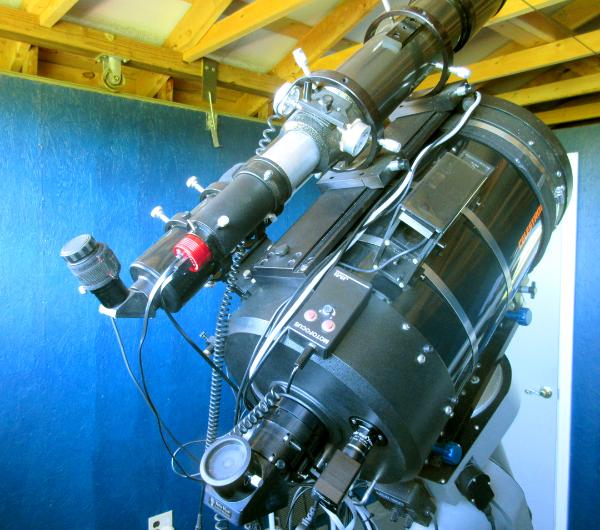Observatory and Equipment |
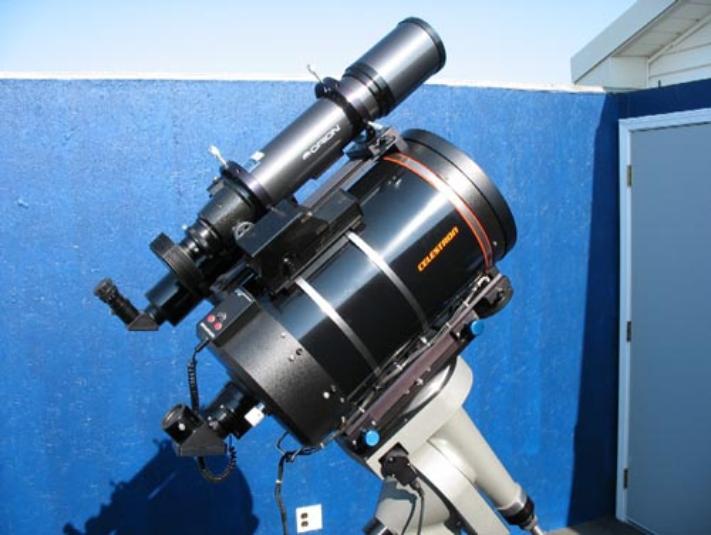
VISUAL EYEPIECES USED AT OZ: Shown
at right are the various eyepieces used for
visual observing. Clockwise, starting at
upperleft: 41mm TeleVue Panoptic (70X, 57
min. fleld ), 31mm TeleVue Nagler type 5
(90X, 53min. field ), 20mm TeleVue Nagler
type 2 (140X, 37 min. field), 16mm TeleVue
Nagler type 2 (175X, 28 min. field), 14mm
E.S. 100deg. (200X, 30 min. field), 12mm
TeleVue Nagler type 4 (233X, 21 min. field),
9mm TeleVue Nagler type 6 (311X, 15 min.
field).
at right are the various eyepieces used for
visual observing. Clockwise, starting at
upperleft: 41mm TeleVue Panoptic (70X, 57
min. fleld ), 31mm TeleVue Nagler type 5
(90X, 53min. field ), 20mm TeleVue Nagler
type 2 (140X, 37 min. field), 16mm TeleVue
Nagler type 2 (175X, 28 min. field), 14mm
E.S. 100deg. (200X, 30 min. field), 12mm
TeleVue Nagler type 4 (233X, 21 min. field),
9mm TeleVue Nagler type 6 (311X, 15 min.
field).

Land of Oz Observatory: A 12' X 20' Roll-off roof observatory located
in Linn County, Kansas, about an hour south of the Kansas City metro area.
Construction is standard stud-wall frame construction, with exterior of vinyl
siding and roof of 16-gage corrugated steel. Interior consists of a 12' X 12'
telescope room and a 12' X 8' insulated control room.
in Linn County, Kansas, about an hour south of the Kansas City metro area.
Construction is standard stud-wall frame construction, with exterior of vinyl
siding and roof of 16-gage corrugated steel. Interior consists of a 12' X 12'
telescope room and a 12' X 8' insulated control room.
The left-hand photo shows the C-11 and
the MI-250 Go-To mount, the Gemini I
control and hand pad, as well as the USB
and serial cables that go from the scope
through an under-floor conduit to the
control room. This allows remote
control of both the MI-250 Go-To mount,
the Starlight Express SXVR-H694C or
ZWO-ASI071 imaging cameras and the
ZWO-174mm guiding camera from the
control room. In the background is the
6-inch Newtonian reflector which I built
while in High School.
The photo on the right shows the desk in
the control room, with the Hewlitt
Packard Pavilion g6-201 3.1 gHz
Laptop, which controls the telescope via
The Sky 6 and the guiding and imaging
cameras via Maxim DL. Just to the right
of the laptop is the control box for the
MicroTouch motorized focuser, which
controls focus of the C-11, and to the right
of the MicroTouch control is the control
box of the JMI MotoFocus,which controls
focus of the Orion 80mm guide scope.
the MI-250 Go-To mount, the Gemini I
control and hand pad, as well as the USB
and serial cables that go from the scope
through an under-floor conduit to the
control room. This allows remote
control of both the MI-250 Go-To mount,
the Starlight Express SXVR-H694C or
ZWO-ASI071 imaging cameras and the
ZWO-174mm guiding camera from the
control room. In the background is the
6-inch Newtonian reflector which I built
while in High School.
The photo on the right shows the desk in
the control room, with the Hewlitt
Packard Pavilion g6-201 3.1 gHz
Laptop, which controls the telescope via
The Sky 6 and the guiding and imaging
cameras via Maxim DL. Just to the right
of the laptop is the control box for the
MicroTouch motorized focuser, which
controls focus of the C-11, and to the right
of the MicroTouch control is the control
box of the JMI MotoFocus,which controls
focus of the Orion 80mm guide scope.
| IMAGING AT LAND OF OZ Set-up, hardware & instrumentation used for CCD Imaging |
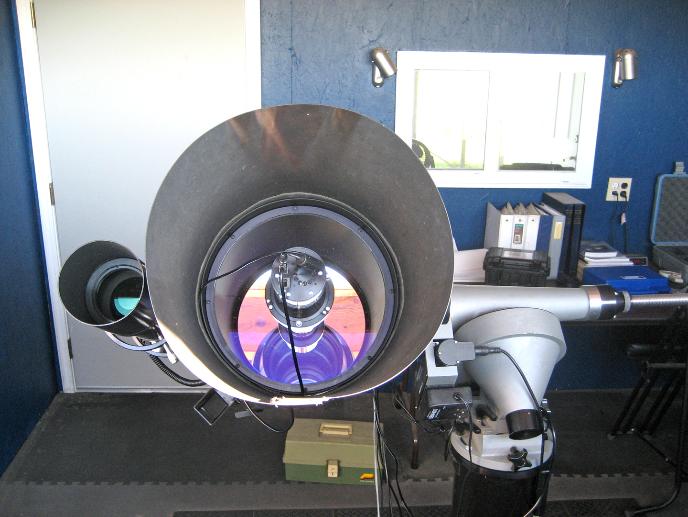

| 10/15/17: NEW WIDE-FIELD IMAGING CAMERA AT OZ |
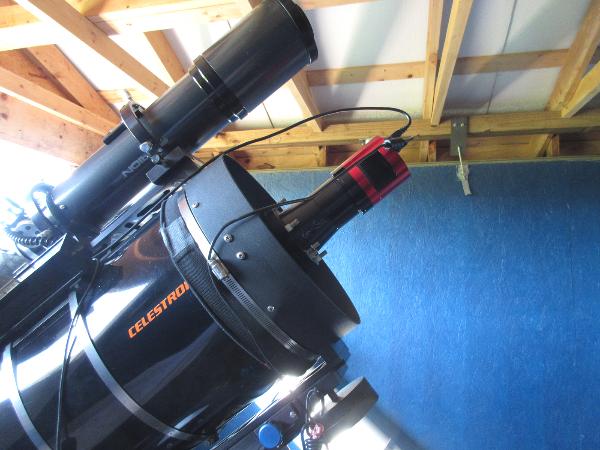
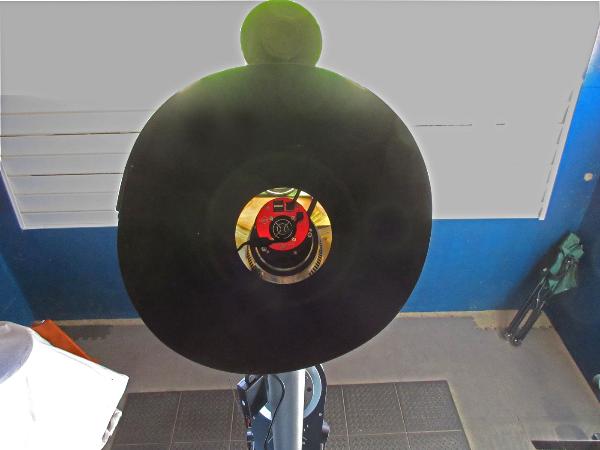
NEW WIDE-FIELD CAMERA SETUP: The two
photos at the right show the latest equipment
installed at Land of Oz Observatory. To the
immediate right is the new ZWO-ASI071-MC 16
megapixel CMOS-based color imager mounted
on the HyperStar lens assembly. Using this
configuration, the new camera has a resolution of
1.76 arc-seconds per pixel and an imaging field
of 145 arc minutes by 95 arc minutes (Approx.
2.5 X 1.5 degrees). The new camera operates
using MAXIM DL5 via an ASCOM link. Images
are downloaded via a dedicated active USB 3.
connection between the camera and the H-P
laptop computer in the adjacent Control Room.
photos at the right show the latest equipment
installed at Land of Oz Observatory. To the
immediate right is the new ZWO-ASI071-MC 16
megapixel CMOS-based color imager mounted
on the HyperStar lens assembly. Using this
configuration, the new camera has a resolution of
1.76 arc-seconds per pixel and an imaging field
of 145 arc minutes by 95 arc minutes (Approx.
2.5 X 1.5 degrees). The new camera operates
using MAXIM DL5 via an ASCOM link. Images
are downloaded via a dedicated active USB 3.
connection between the camera and the H-P
laptop computer in the adjacent Control Room.
MAIN INSTRUMENTS: The primary instrument used
at Land of Oz Observatory is an 11-inch (280mm)
CELESTRON Schmidt-Cassegrain telescope of 110
inch (2800mm) focal length. This telescope is mounted
on a Mountain Instruments MI-250 Go-To German
Equatorial Mount. The MI-250 has a load capacity of
75 pounds, and features massive, conically-shaped
Polar and Declination axes, each driven by 7.5 inch
diameter bronze gears and matching diamond lapped
stainless steel worms.Tracking accuracy of this mount
is better than + or - 4 arc seconds. The mount is
computer controlled via THE SKY 6 software through
the GEMINI 1 controller. The CELESTRON C-11
optical tube assembly is mounted to the MI-250 via a
Robin Casady precision tip-in dovetail saddle
assembly. An Orion ED-80 80mm (3.1") Apochromatic
refractor, used for guiding, is mounted co-axially on the
C-11 tube assembly via Losmandy heavy duty dove-
tails and 150mm heavy duty rings. A 12 X 80mm
Antares erect-image finder and a Telrad reflex-type
finder are also mounted on the C-11 tube assembly.
at Land of Oz Observatory is an 11-inch (280mm)
CELESTRON Schmidt-Cassegrain telescope of 110
inch (2800mm) focal length. This telescope is mounted
on a Mountain Instruments MI-250 Go-To German
Equatorial Mount. The MI-250 has a load capacity of
75 pounds, and features massive, conically-shaped
Polar and Declination axes, each driven by 7.5 inch
diameter bronze gears and matching diamond lapped
stainless steel worms.Tracking accuracy of this mount
is better than + or - 4 arc seconds. The mount is
computer controlled via THE SKY 6 software through
the GEMINI 1 controller. The CELESTRON C-11
optical tube assembly is mounted to the MI-250 via a
Robin Casady precision tip-in dovetail saddle
assembly. An Orion ED-80 80mm (3.1") Apochromatic
refractor, used for guiding, is mounted co-axially on the
C-11 tube assembly via Losmandy heavy duty dove-
tails and 150mm heavy duty rings. A 12 X 80mm
Antares erect-image finder and a Telrad reflex-type
finder are also mounted on the C-11 tube assembly.
10/15/2012: A view of the HyperStar f/2 imaging
system mounted on the corrector lens of the C-11
along with the Starlight Express SXVR-H694C
6 megapixel one-shot color CCD camera. Using
this system, the f/10 C-11 becomes an f/2, with a
focal length of 560mm yielding an imaging field of
77 X 61 arc minutes and a resolution of 1.67 arc
seconds per pixel. This camera uses the super
sensitive SONY ICX694 detector with 4.5 micron
pixels and set-point thermo-electric cooling.
Shown to the left of the C-11 tube assembly is the
ORION ED80 80mm (3.1") guiding refractor. With
a focal length of 600mm and using the ZWO
174mm guiding camera, it has a resolution of
2 arc seconds per pixel. This scope is mounted
co-axially using Losmandy heavy duty dovetails
and 150mm heavy duty rings. This setup is very
rigid and has shown NO evidence of differential
flexure, even during 10 minute exposures. Also
shown in this view is themassive, conical Polar
axis of the MI-250 mount.
system mounted on the corrector lens of the C-11
along with the Starlight Express SXVR-H694C
6 megapixel one-shot color CCD camera. Using
this system, the f/10 C-11 becomes an f/2, with a
focal length of 560mm yielding an imaging field of
77 X 61 arc minutes and a resolution of 1.67 arc
seconds per pixel. This camera uses the super
sensitive SONY ICX694 detector with 4.5 micron
pixels and set-point thermo-electric cooling.
Shown to the left of the C-11 tube assembly is the
ORION ED80 80mm (3.1") guiding refractor. With
a focal length of 600mm and using the ZWO
174mm guiding camera, it has a resolution of
2 arc seconds per pixel. This scope is mounted
co-axially using Losmandy heavy duty dovetails
and 150mm heavy duty rings. This setup is very
rigid and has shown NO evidence of differential
flexure, even during 10 minute exposures. Also
shown in this view is themassive, conical Polar
axis of the MI-250 mount.
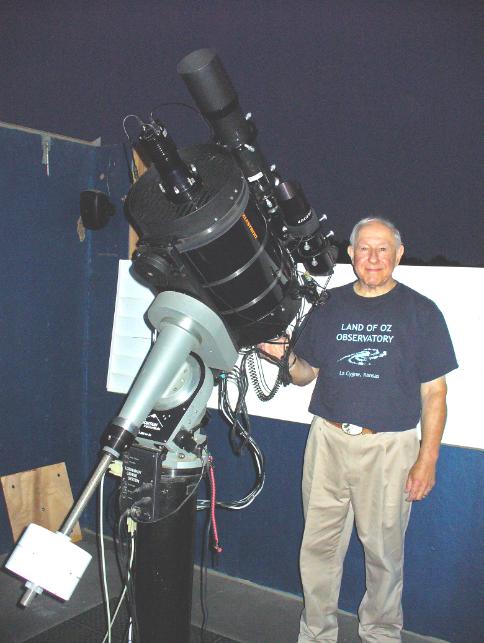
SETTING UP FOR A NIGHT OF
IMAGING AT LAND OF OZ:
This photo was taken by my good
friend Dave Hudgins in July of 2018.
Shown are the Celestron 11-inch
telescope on the Mountain Instruments
MI-250 mount, along with the 80mm
APO refractor guiding scope and the
Starlight Express SXVR-H694C camera
mounted on the HyperStar
imagingadapter. A Bahtinov mask has
been mounted on the corrector plate
in preparation for fine focusing the
camera.This setup has been my
primaryastro-imaging rig for the past 5
years.Results from this rig appear on
theCCD Images page of this website.
Thanks, Dave, for this great photo!
IMAGING AT LAND OF OZ:
This photo was taken by my good
friend Dave Hudgins in July of 2018.
Shown are the Celestron 11-inch
telescope on the Mountain Instruments
MI-250 mount, along with the 80mm
APO refractor guiding scope and the
Starlight Express SXVR-H694C camera
mounted on the HyperStar
imagingadapter. A Bahtinov mask has
been mounted on the corrector plate
in preparation for fine focusing the
camera.This setup has been my
primaryastro-imaging rig for the past 5
years.Results from this rig appear on
theCCD Images page of this website.
Thanks, Dave, for this great photo!
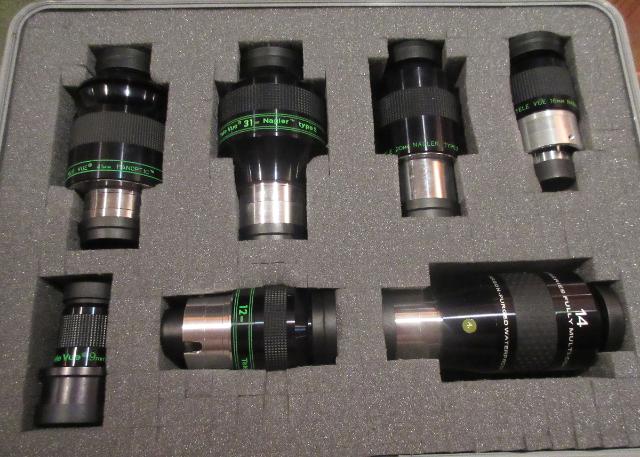

The Photo to the Far Right is a close-up
view of the Micro-Touch Stepper Motor
Focuser and the cable connecting it to the
remote controller in the Control Room.
view of the Micro-Touch Stepper Motor
Focuser and the cable connecting it to the
remote controller in the Control Room.
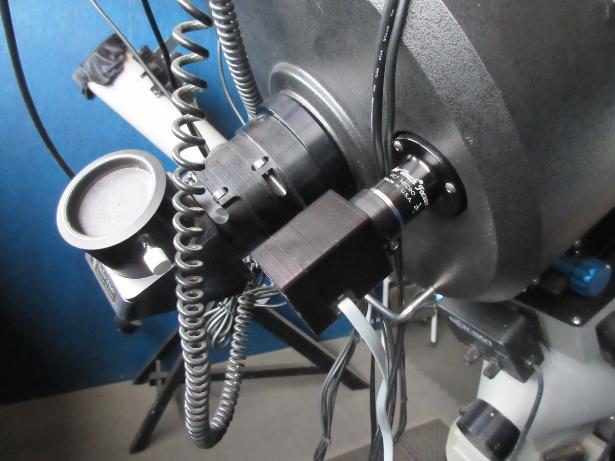
NEAR RIGHT: View of the optical tube of
the C-11 showing the ORION ED-80mm
guide scope and ZWO-ASI 174 mm
guiding camera mounted via LOSMANDY
heavy duty dovetails and rings. Also
shown is the Micro-Touch stepper motor
focuser for the 11-inch f/2 main mirror. This
stepper motor turns the focus screw
1/3000th of a revolution per step,
providing very precise focus adjustments.
It is connected to a focuser hand control
located in the adjacent Control Room via
an under-floor cable. The ZWO 174mm
guiding camera sends guiding corrections
to the MI-250 mount using guiding
software in the MAXIM DL-5 camera
control software.
the C-11 showing the ORION ED-80mm
guide scope and ZWO-ASI 174 mm
guiding camera mounted via LOSMANDY
heavy duty dovetails and rings. Also
shown is the Micro-Touch stepper motor
focuser for the 11-inch f/2 main mirror. This
stepper motor turns the focus screw
1/3000th of a revolution per step,
providing very precise focus adjustments.
It is connected to a focuser hand control
located in the adjacent Control Room via
an under-floor cable. The ZWO 174mm
guiding camera sends guiding corrections
to the MI-250 mount using guiding
software in the MAXIM DL-5 camera
control software.
